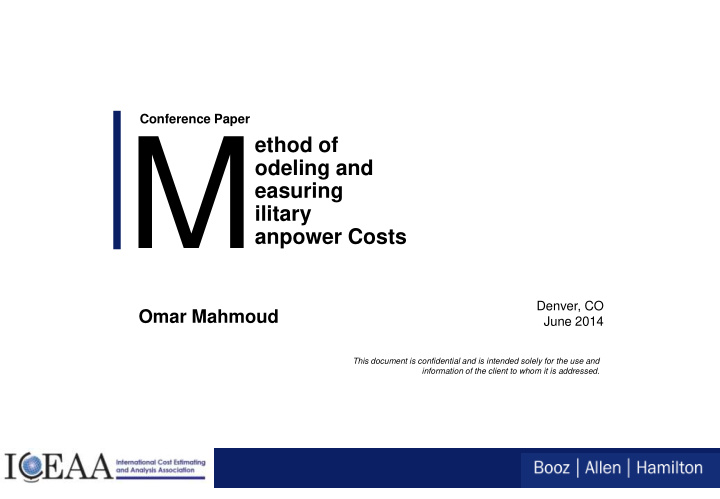



Conference Paper M ethod of odeling and easuring ilitary anpower Costs Denver, CO Omar Mahmoud June 2014 This document is confidential and is intended solely for the use and information of the client to whom it is addressed.
Table Of Contents Problem Statement Establish a Baseline Estimate Conduct the Manpower Survey Normalize Survey Inputs Benefits and Challenges Summary 1
Problem Statement For a Major ACAT 1A program, military manpower costs was the leading cost driver affecting the program’s Total Ownership Cost (TOC) – System documentation lacked periodicity and frequency of User’s system usage --> each User was estimated at 100% utilization • User base > 1,000 FTEs* in a given year • System Usage cost > $1B* over its projected lifecycle The program tried to ascertain how much of the system usage was actually being spent by its user base in order to re-baseline the programs #1 cost driver — Military Manpower Costs. Disclaimer: *FTE figures and cost estimate are not actuals from any actual program. They are used to for ILLUSTRATION PURPOSES ONLY 2
Table Of Contents Problem Statement Establish a Baseline Estimate Conduct the Manpower Survey Normalize Survey Inputs Benefits and Challenges Summary 3
Establish a Baseline Estimate Leverage existing data if available that describes the system’s manpower requirements such as: – Cost Analysis Requirements Description document (CARD) – Navy Training Systems Plan (NTSP) – Training Planning Process Methodology (TRPPM) These documents were used to establish the program’s baseline User base estimate 4
Establish a Baseline Estimate (cont’d) Documents such as the NTSP/CARD/TRPPM lay the framework for the total expected Billets required to Maintain, Administer, Watch, and Operate a program’s system A program’s installation profile is used to determine when system utilization occurs Military Composite Rates determine the cost of required billets Leveraging these data sources establishes the baseline manpower estimate 5
Table Of Contents Problem Statement Establish a Baseline Estimate Conduct the Manpower Survey Normalize Survey Inputs Benefits and Challenges Summary 6
Conduct the Manpower Survey This formula is what drives many User based cost estimates: The missing variable in the equation above is “system utilization” – System Utilization Definition - Depicts the frequency in which a User uses, configures, manipulates, analyzes, administers, and/or maintains the system while on “underway” AND is specific to the system being estimated, where: A manpower survey was conducted to determine the amount of System Utilization for a given User – Specify User’s Function (i.e., Watch Officer, Sys Admin, Maintainer, etc .) – Indicate Ship Class the User Supported (i.e., CVN, FFG, Training site) – Determine % of time using, configuring, manipulating, analyzing, administering, and or maintaining the specific system while underway (i.e., not in-port) 7
Table Of Contents Problem Statement Establish a Baseline Estimate Conduct the Manpower Survey Normalize Survey Inputs Benefits and Challenges Summary 8
Normalize Survey Inputs Consolidate inputs from the manpower survey by ship class and function to determine average system utilization – Be sure to factor: • System usage while “underway” • User’s system operation over a 24 hour period* * User’s shift length was assumed to 6 working hours out of a 24 hour period 9
Table Of Contents Problem Statement Establish a Baseline Estimate Conduct the Manpower Survey Normalize Survey Inputs Benefits and Challenges Summary 10
Benefits and Challenges Benefits Survey can be developed in a short amount of time Economic Analysis and program ROI decisions Establish ACAT designation based on a sound methodology Challenges Fleet Coordination can be time consuming and may involve multiple individuals Obtaining an adequate number of responses can be difficult Follow-up to clarify erroneous responses is practically impossible 11
Table Of Contents Problem Statement Establish a Baseline Estimate Conduct the Manpower Survey Normalize Survey Inputs Benefits and Challenges Summary 12
Summary Very successful collaboration between the program office and the fleet – Survey was simplistic and easy to understand – Received over 300 responses from the system’s User community Survey is now being utilized to re- baseline the program’s cost estimate and is also being leveraged to baseline other analogous programs TOC estimate Estimate Prior to Estimate Using Results Manpower Survey of Manpower Survey User Base: > 1,000 FTEs ~90 FTEs User Specific Cost $1B $90M Estimate: Potential Impact on ACAT 1 threshold ACAT III threshold ACAT Designation: 13
For further information . . . Omar Mahmoud Lead Associate Booz | Allen | Hamilton Booz Allen Hamilton Inc. 1615 Murray Canyon Rd Suite 140 San Diego, CA 92108 714.421.1231 Mahmoud_Omar@bah.com 14
Back-up Slides 15
ACAT Thresholds > $32M in FY2000 constant dollars for all expenditures, for all releases, regardless of appropriation or funding source, directly related to the AIS definition, design, development, and deployment incurred in any single fiscal year ACAT IA* > $126M in FY2000 constant dollars for all expenditures, for all releases, regardless of appropriation or funding source, directly related to the AIS definition, design, development, and deployment incurred from the beginning of the Materiel Solution Analysis Phase through deployment at all sites > $378M in FY2000 constant dollars for all expenditures, for all releases, regardless of appropriation or funding source, directly related to the AIS definition, design, development, deployment, operations, maintenance, and incurred from the beginning of the Materiel Solution Analysis Phase through sustainment for the estimated useful life of the system. ACAT III** $15M ≤ Program costs/year ≤ $32M in FY2000 constant dollars $30M ≤ Total Program costs/year ≤ $126M in FY2000 constant dollars Total life-cycle costs ≤ $378M in FY2000 constant dollars *Source : DoDI 5000.02E, CH 144A Reference K **Source : SECNAV INST 5000 16
Recommend
More recommend